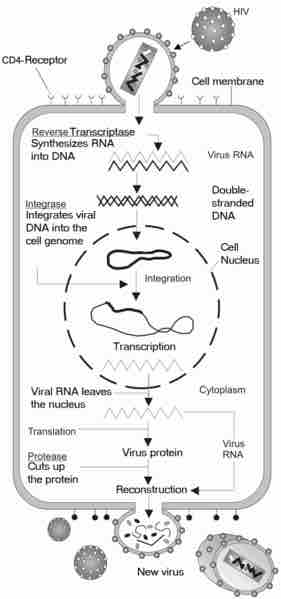A tropism is a biological phenomenon, indicating growth or turning movement of a biological organism in response to an environmental stimulus. In tropisms, this response is dependent on the direction of the stimulus (as opposed to nastic movements which are non-directional responses). Viruses and other pathogens also affect what is called "host tropism" or "cell tropism. " Case tropism refers to the way in which different viruses/pathogens have evolved to preferentially target specific host species or specific cell types within those species.
Host tropism is the name given to a process of tropism that determines which cells can become infected by a given pathogen. Host tropism is determined by the biochemical receptor complexes on cell surfaces that are permissive or non-permissive to the docking or attachment of various viruses.
Various factors determine the ability of a pathogen to infect a particular cell. For example, viruses must bind to specific cell surface receptors to enter a cell. If a cell does not express these receptors then the virus cannot normally infect it. Viral tropism is determined by a combination of susceptibility and permissiveness: a host cell must be both permissive (allow viral entry) and susceptible (possess the receptor complement needed for viral entry) for a virus to establish infection. An example of this is the HIV virus, which exhibits tropism for CD4 related immune cells (e.g. T helper cells, macrophages or dendritic cells). These cells express a CD4 receptor, to which the HIV virus can bind, through the gp120 and gp41 proteins on its surface .
Human papillomavirus vaccine
Gardasil is a human papillomavirus vaccine on the market and it protects against HPV-16 and HPV-18 which cause 70% of cervical cancers, 80% of anal cancers, 60% of vaginal cancers, and 40% of vulvar cancers.
In virology, Tissue tropism is the cells and tissues of a host that support growth of a particular virus or bacteria. Some viruses have a broad tissue tropism and can infect many types of cells and tissues. Other viruses may infect primarily a single tissue.
Factors influencing viral tissue tropism include: 1) the presence of cellular receptors permitting viral entry, 2) availability of transcription factors involved in viral replication, 3) the molecular nature of the viral tropogen, and 4) the cellular receptors are the proteins found on a cell or viral surface.
These receptors are like keys allowing the viral cell to fuse with a cell or attach itself to a cell. The way that these proteins are acquired is through similar process to that of an infection cycle.

HIV life cycle
HIV has a gp120 which is precisely what the CD4 marker is on the surface of the macrophages and T cells. Therefore, HIV can enter T cells and macrophages.